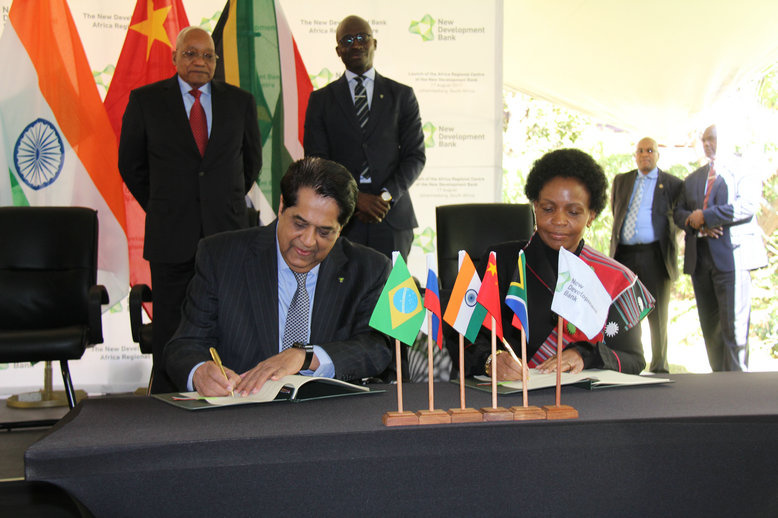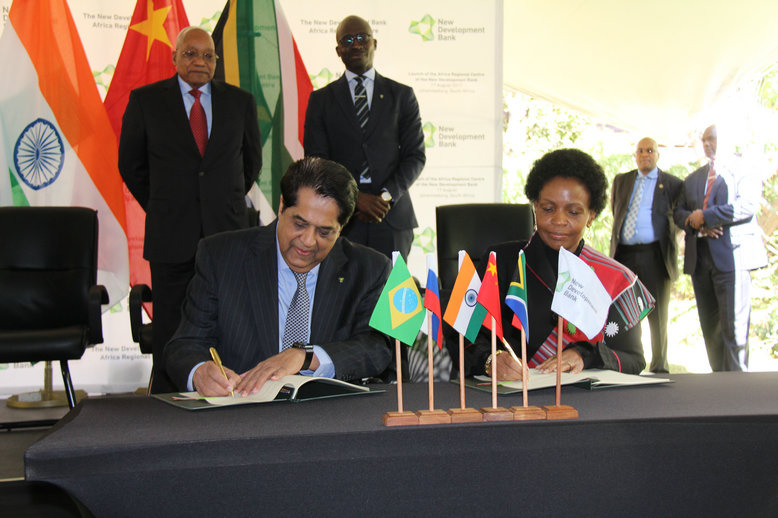By Zhong Sheng from People’s Daily

The BRICS New Development Bank (NDB) launched its Africa Regional Center in Johannesburg on Thursday, with South African President Jacob Zuma presiding over the proceedings.
Zuma hailed the launch as a historic moment that underlined the BRICS’ commitment to the development of the African continent. As the first-ever branch of the NDB in Africa, the center will help the bank better proceed and reserve projects on the continent.
The NDB is an important organ of the BRICS mechanism. According to the World Bank, developing countries need $1 trillion for infrastructure construction but traditional multilateral development banks can provide only 40 percent of the funding needed.
How to break the fundraising bottleneck faced by emerging markets and developing countries and promote inclusive and sustainable development? BRICS countries have chosen to consolidate and build a community of shared interests.
As a multilateral development organization built entirely by emerging markets, the NDB shoulders the heavy responsibility of strengthening the partnership of common development and boosting common prosperity for developing countries.
The NDB was first proposed in 2012 and proved its viability in 2013. In 2014, an agreement was signed on the bank.
In 2015, the bank officially opened, and in 2016 it announced the first batch of loan projects and issued the first green financial bond. The achievements it has made to date demonstrate strong execution and also strongly refute the doubts and naysayers from Western countries about the bloc.
The NDB facilitates the common development of BRICS member countries. In 2016 alone, the bank ratified seven projects for five member countries with a total value of $1.5 billion, most of which is in the green energy and transportation sectors.
This year, the bank is expected to approve 10 to 15 loan projects with a total value of $2.5-$3 billion. In the next five years, the bank plans to allocate two-thirds of its loans to boost infrastructure construction.
“The history of development of emerging markets represented by China has displayed the significance of sustainable development. Infrastructure construction, which supports sustainable development, matters a lot to BRICS countries and explains why the NDB hopes to put more resources into the sector, ” said NDB president Kundapur Vaman Kamath.
The NDB injects new impetus into the BRICS-led South-South cooperation. The cooperation mechanism among BRICS countries has set an example for emerging markets and developing countries and has become an important platform for South-South cooperation in the 21st century.
The BRICS cooperation with the spirit of openness has not only expanded the space and range of cooperation, but also brought new development opportunities for developing countries and promoted the steady operation of South-South cooperation.
Currently, the NDB is working to extend its loan services to other emerging markets and developing countries. The launch of the Africa Regional Center will greatly propel infrastructure construction and narrow the deficit in development for African countries.
The upcoming BRICS Summit in the southeastern Chinese city of Xiamen in September, as an innovative exploration of the “BRICS plus” model, will inject more confidence into South-South cooperation.
Zuma hailed the launch as a historic moment that underlined the BRICS’ commitment to the development of the African continent. As the first-ever branch of the NDB in Africa, the center will help the bank better proceed and reserve projects on the continent.
The NDB is an important organ of the BRICS mechanism. According to the World Bank, developing countries need $1 trillion for infrastructure construction but traditional multilateral development banks can provide only 40 percent of the funding needed.
How to break the fundraising bottleneck faced by emerging markets and developing countries and promote inclusive and sustainable development? BRICS countries have chosen to consolidate and build a community of shared interests.
As a multilateral development organization built entirely by emerging markets, the NDB shoulders the heavy responsibility of strengthening the partnership of common development and boosting common prosperity for developing countries.
The NDB was first proposed in 2012 and proved its viability in 2013. In 2014, an agreement was signed on the bank.
In 2015, the bank officially opened, and in 2016 it announced the first batch of loan projects and issued the first green financial bond. The achievements it has made to date demonstrate strong execution and also strongly refute the doubts and naysayers from Western countries about the bloc.
The NDB facilitates the common development of BRICS member countries. In 2016 alone, the bank ratified seven projects for five member countries with a total value of $1.5 billion, most of which is in the green energy and transportation sectors.
This year, the bank is expected to approve 10 to 15 loan projects with a total value of $2.5-$3 billion. In the next five years, the bank plans to allocate two-thirds of its loans to boost infrastructure construction.
“The history of development of emerging markets represented by China has displayed the significance of sustainable development. Infrastructure construction, which supports sustainable development, matters a lot to BRICS countries and explains why the NDB hopes to put more resources into the sector, ” said NDB president Kundapur Vaman Kamath.
The NDB injects new impetus into the BRICS-led South-South cooperation. The cooperation mechanism among BRICS countries has set an example for emerging markets and developing countries and has become an important platform for South-South cooperation in the 21st century.
The BRICS cooperation with the spirit of openness has not only expanded the space and range of cooperation, but also brought new development opportunities for developing countries and promoted the steady operation of South-South cooperation.
Currently, the NDB is working to extend its loan services to other emerging markets and developing countries. The launch of the Africa Regional Center will greatly propel infrastructure construction and narrow the deficit in development for African countries.
The upcoming BRICS Summit in the southeastern Chinese city of Xiamen in September, as an innovative exploration of the “BRICS plus” model, will inject more confidence into South-South cooperation.
 Menu
Menu
 Op-ed: BRICS mechanism opens up new prospects for South-South cooperation
Op-ed: BRICS mechanism opens up new prospects for South-South cooperation
















